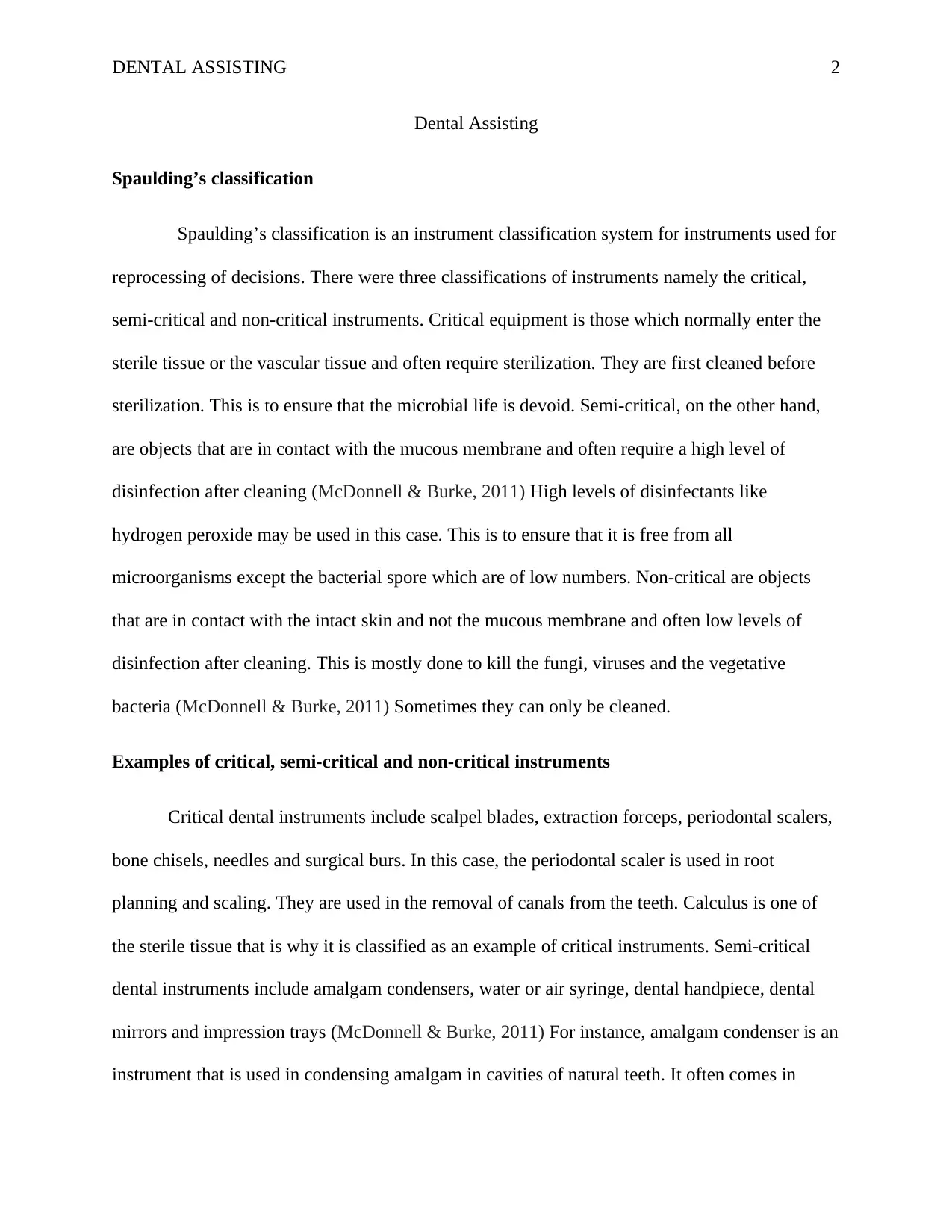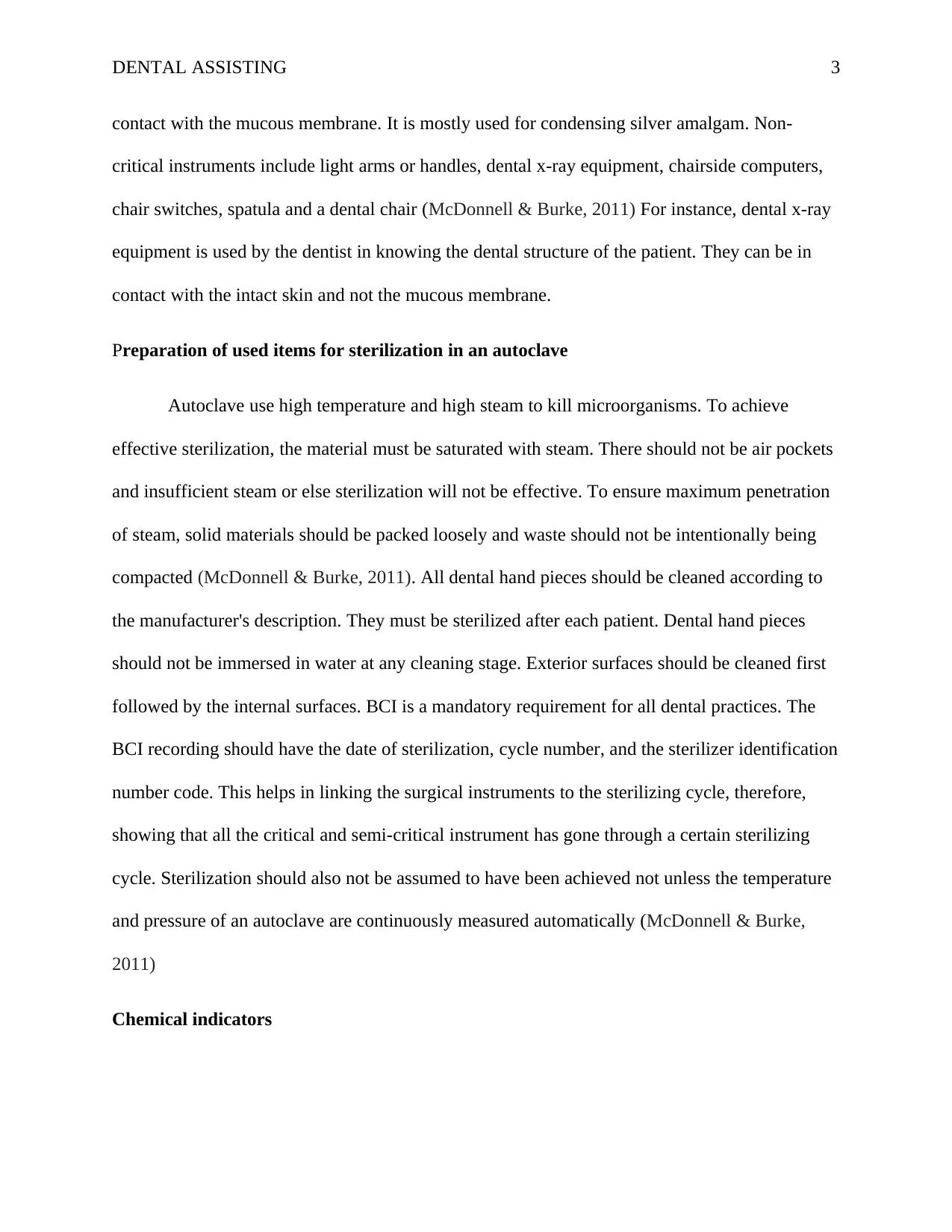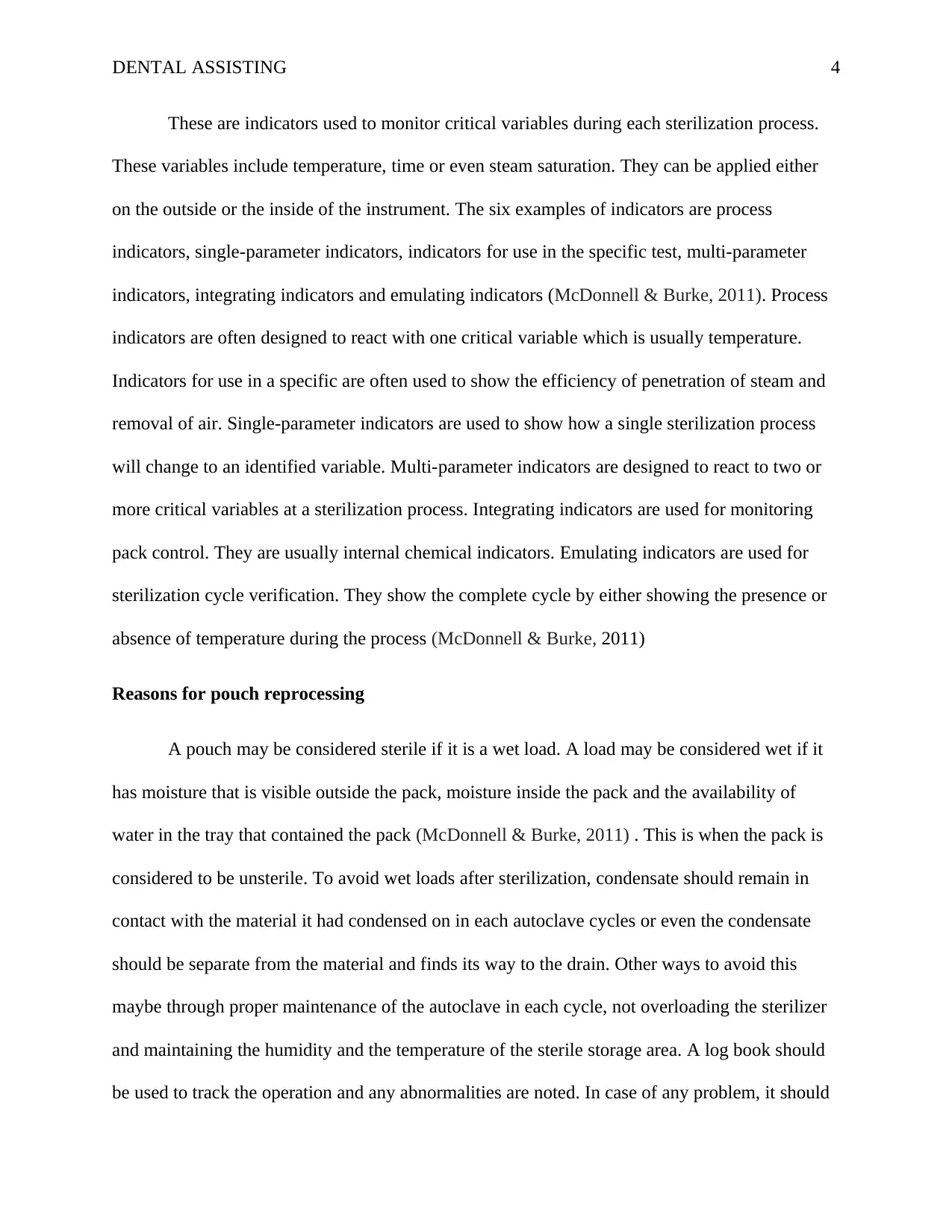HLTINF002: Dental Assisting - Processing Reusable Medical Devices
VerifiedAdded on 2023/06/12
|7
|1541
|342
Report
AI Summary
This report provides a detailed overview of processing reusable medical devices and equipment in dental assisting. It covers Spaulding's classification of instruments into critical, semi-critical, and non-critical categories, outlining examples for each. The report also details the preparation of used items for sterilization in an autoclave, emphasizing the importance of steam saturation and proper cleaning procedures, including the use of chemical indicators to monitor sterilization processes. Furthermore, it addresses reasons for pouch reprocessing, methods to avoid wet loads, and the necessity of removing blood, saliva, and other debris from instruments before sterilization using methods like ultrasonic cleaners and manual scrubbing. Finally, the report explains the importance of Safety Data Sheets (SDS) in identifying hazards and ensuring safe handling of chemical products, including information on first aid, disposal, and transport considerations. This comprehensive analysis supports effective infection control and safety practices in dental assisting.

Running head: DENTAL ASSISTING 1
Dental Assisting
Name
Institution
Dental Assisting
Name
Institution
Paraphrase This Document
Need a fresh take? Get an instant paraphrase of this document with our AI Paraphraser

DENTAL ASSISTING 2
Dental Assisting
Spaulding’s classification
Spaulding’s classification is an instrument classification system for instruments used for
reprocessing of decisions. There were three classifications of instruments namely the critical,
semi-critical and non-critical instruments. Critical equipment is those which normally enter the
sterile tissue or the vascular tissue and often require sterilization. They are first cleaned before
sterilization. This is to ensure that the microbial life is devoid. Semi-critical, on the other hand,
are objects that are in contact with the mucous membrane and often require a high level of
disinfection after cleaning (McDonnell & Burke, 2011) High levels of disinfectants like
hydrogen peroxide may be used in this case. This is to ensure that it is free from all
microorganisms except the bacterial spore which are of low numbers. Non-critical are objects
that are in contact with the intact skin and not the mucous membrane and often low levels of
disinfection after cleaning. This is mostly done to kill the fungi, viruses and the vegetative
bacteria (McDonnell & Burke, 2011) Sometimes they can only be cleaned.
Examples of critical, semi-critical and non-critical instruments
Critical dental instruments include scalpel blades, extraction forceps, periodontal scalers,
bone chisels, needles and surgical burs. In this case, the periodontal scaler is used in root
planning and scaling. They are used in the removal of canals from the teeth. Calculus is one of
the sterile tissue that is why it is classified as an example of critical instruments. Semi-critical
dental instruments include amalgam condensers, water or air syringe, dental handpiece, dental
mirrors and impression trays (McDonnell & Burke, 2011) For instance, amalgam condenser is an
instrument that is used in condensing amalgam in cavities of natural teeth. It often comes in
Dental Assisting
Spaulding’s classification
Spaulding’s classification is an instrument classification system for instruments used for
reprocessing of decisions. There were three classifications of instruments namely the critical,
semi-critical and non-critical instruments. Critical equipment is those which normally enter the
sterile tissue or the vascular tissue and often require sterilization. They are first cleaned before
sterilization. This is to ensure that the microbial life is devoid. Semi-critical, on the other hand,
are objects that are in contact with the mucous membrane and often require a high level of
disinfection after cleaning (McDonnell & Burke, 2011) High levels of disinfectants like
hydrogen peroxide may be used in this case. This is to ensure that it is free from all
microorganisms except the bacterial spore which are of low numbers. Non-critical are objects
that are in contact with the intact skin and not the mucous membrane and often low levels of
disinfection after cleaning. This is mostly done to kill the fungi, viruses and the vegetative
bacteria (McDonnell & Burke, 2011) Sometimes they can only be cleaned.
Examples of critical, semi-critical and non-critical instruments
Critical dental instruments include scalpel blades, extraction forceps, periodontal scalers,
bone chisels, needles and surgical burs. In this case, the periodontal scaler is used in root
planning and scaling. They are used in the removal of canals from the teeth. Calculus is one of
the sterile tissue that is why it is classified as an example of critical instruments. Semi-critical
dental instruments include amalgam condensers, water or air syringe, dental handpiece, dental
mirrors and impression trays (McDonnell & Burke, 2011) For instance, amalgam condenser is an
instrument that is used in condensing amalgam in cavities of natural teeth. It often comes in

DENTAL ASSISTING 3
contact with the mucous membrane. It is mostly used for condensing silver amalgam. Non-
critical instruments include light arms or handles, dental x-ray equipment, chairside computers,
chair switches, spatula and a dental chair (McDonnell & Burke, 2011) For instance, dental x-ray
equipment is used by the dentist in knowing the dental structure of the patient. They can be in
contact with the intact skin and not the mucous membrane.
Preparation of used items for sterilization in an autoclave
Autoclave use high temperature and high steam to kill microorganisms. To achieve
effective sterilization, the material must be saturated with steam. There should not be air pockets
and insufficient steam or else sterilization will not be effective. To ensure maximum penetration
of steam, solid materials should be packed loosely and waste should not be intentionally being
compacted (McDonnell & Burke, 2011). All dental hand pieces should be cleaned according to
the manufacturer's description. They must be sterilized after each patient. Dental hand pieces
should not be immersed in water at any cleaning stage. Exterior surfaces should be cleaned first
followed by the internal surfaces. BCI is a mandatory requirement for all dental practices. The
BCI recording should have the date of sterilization, cycle number, and the sterilizer identification
number code. This helps in linking the surgical instruments to the sterilizing cycle, therefore,
showing that all the critical and semi-critical instrument has gone through a certain sterilizing
cycle. Sterilization should also not be assumed to have been achieved not unless the temperature
and pressure of an autoclave are continuously measured automatically (McDonnell & Burke,
2011)
Chemical indicators
contact with the mucous membrane. It is mostly used for condensing silver amalgam. Non-
critical instruments include light arms or handles, dental x-ray equipment, chairside computers,
chair switches, spatula and a dental chair (McDonnell & Burke, 2011) For instance, dental x-ray
equipment is used by the dentist in knowing the dental structure of the patient. They can be in
contact with the intact skin and not the mucous membrane.
Preparation of used items for sterilization in an autoclave
Autoclave use high temperature and high steam to kill microorganisms. To achieve
effective sterilization, the material must be saturated with steam. There should not be air pockets
and insufficient steam or else sterilization will not be effective. To ensure maximum penetration
of steam, solid materials should be packed loosely and waste should not be intentionally being
compacted (McDonnell & Burke, 2011). All dental hand pieces should be cleaned according to
the manufacturer's description. They must be sterilized after each patient. Dental hand pieces
should not be immersed in water at any cleaning stage. Exterior surfaces should be cleaned first
followed by the internal surfaces. BCI is a mandatory requirement for all dental practices. The
BCI recording should have the date of sterilization, cycle number, and the sterilizer identification
number code. This helps in linking the surgical instruments to the sterilizing cycle, therefore,
showing that all the critical and semi-critical instrument has gone through a certain sterilizing
cycle. Sterilization should also not be assumed to have been achieved not unless the temperature
and pressure of an autoclave are continuously measured automatically (McDonnell & Burke,
2011)
Chemical indicators
⊘ This is a preview!⊘
Do you want full access?
Subscribe today to unlock all pages.

Trusted by 1+ million students worldwide

DENTAL ASSISTING 4
These are indicators used to monitor critical variables during each sterilization process.
These variables include temperature, time or even steam saturation. They can be applied either
on the outside or the inside of the instrument. The six examples of indicators are process
indicators, single-parameter indicators, indicators for use in the specific test, multi-parameter
indicators, integrating indicators and emulating indicators (McDonnell & Burke, 2011). Process
indicators are often designed to react with one critical variable which is usually temperature.
Indicators for use in a specific are often used to show the efficiency of penetration of steam and
removal of air. Single-parameter indicators are used to show how a single sterilization process
will change to an identified variable. Multi-parameter indicators are designed to react to two or
more critical variables at a sterilization process. Integrating indicators are used for monitoring
pack control. They are usually internal chemical indicators. Emulating indicators are used for
sterilization cycle verification. They show the complete cycle by either showing the presence or
absence of temperature during the process (McDonnell & Burke, 2011)
Reasons for pouch reprocessing
A pouch may be considered sterile if it is a wet load. A load may be considered wet if it
has moisture that is visible outside the pack, moisture inside the pack and the availability of
water in the tray that contained the pack (McDonnell & Burke, 2011) . This is when the pack is
considered to be unsterile. To avoid wet loads after sterilization, condensate should remain in
contact with the material it had condensed on in each autoclave cycles or even the condensate
should be separate from the material and finds its way to the drain. Other ways to avoid this
maybe through proper maintenance of the autoclave in each cycle, not overloading the sterilizer
and maintaining the humidity and the temperature of the sterile storage area. A log book should
be used to track the operation and any abnormalities are noted. In case of any problem, it should
These are indicators used to monitor critical variables during each sterilization process.
These variables include temperature, time or even steam saturation. They can be applied either
on the outside or the inside of the instrument. The six examples of indicators are process
indicators, single-parameter indicators, indicators for use in the specific test, multi-parameter
indicators, integrating indicators and emulating indicators (McDonnell & Burke, 2011). Process
indicators are often designed to react with one critical variable which is usually temperature.
Indicators for use in a specific are often used to show the efficiency of penetration of steam and
removal of air. Single-parameter indicators are used to show how a single sterilization process
will change to an identified variable. Multi-parameter indicators are designed to react to two or
more critical variables at a sterilization process. Integrating indicators are used for monitoring
pack control. They are usually internal chemical indicators. Emulating indicators are used for
sterilization cycle verification. They show the complete cycle by either showing the presence or
absence of temperature during the process (McDonnell & Burke, 2011)
Reasons for pouch reprocessing
A pouch may be considered sterile if it is a wet load. A load may be considered wet if it
has moisture that is visible outside the pack, moisture inside the pack and the availability of
water in the tray that contained the pack (McDonnell & Burke, 2011) . This is when the pack is
considered to be unsterile. To avoid wet loads after sterilization, condensate should remain in
contact with the material it had condensed on in each autoclave cycles or even the condensate
should be separate from the material and finds its way to the drain. Other ways to avoid this
maybe through proper maintenance of the autoclave in each cycle, not overloading the sterilizer
and maintaining the humidity and the temperature of the sterile storage area. A log book should
be used to track the operation and any abnormalities are noted. In case of any problem, it should
Paraphrase This Document
Need a fresh take? Get an instant paraphrase of this document with our AI Paraphraser

DENTAL ASSISTING 5
be reported to the repair people as soon as possible. A note should be placed on the equipment so
as to give a caution to others not to use the autoclave (McDonnell & Burke, 2011).
The need to remove blood, saliva and other debris from instruments before sterilization
Cleaning is the first step before sterilization and involves the removal of blood, proteins,
microorganisms and other debris from the instruments (McDonnell & Burke, 2011). This often
prepares the instrument for safe handling and helps in infection control. This is achieved through
the use of detergents. One method is the use of ultrasonic cleaner, and it uses sound waves of
high frequency to provide agitation in a detergent to remove debris. It involves the use of
enzymatic solutions to remove debris because of its effectiveness. In this, the potential of
contamination is minimized (McDonnell & Burke, 2011). Scrubbing the instrument using a
detergent is also one method of removing the debris. This is the manual removal of debris from
an instrument. manual cleaning is one advantage of flexibility because any type of instrument
can be cleaned. The disadvantage is that the cleanliness of the instrument is often different from
one worker to another. The worker is also prone to infection. The use of automatic washer is
another method of cleaning. They use automatic cleaning machines. Ultrasonic cleaning lessens
the chance of contamination (McDonnell & Burke, 2011).
The Information contained in the Safety Data Sheet
SDS sheets provide information on the data used to identify the hazards. It is a document
containing information about potential hazards for example fire, reactivity, environmental and
health. It also provides information on how to work safely with certain chemical products
(Ronald, 2012). For complete development of safety and health program, a safety data sheet
should be the starting point. It contains product information, product name, suppliers and
be reported to the repair people as soon as possible. A note should be placed on the equipment so
as to give a caution to others not to use the autoclave (McDonnell & Burke, 2011).
The need to remove blood, saliva and other debris from instruments before sterilization
Cleaning is the first step before sterilization and involves the removal of blood, proteins,
microorganisms and other debris from the instruments (McDonnell & Burke, 2011). This often
prepares the instrument for safe handling and helps in infection control. This is achieved through
the use of detergents. One method is the use of ultrasonic cleaner, and it uses sound waves of
high frequency to provide agitation in a detergent to remove debris. It involves the use of
enzymatic solutions to remove debris because of its effectiveness. In this, the potential of
contamination is minimized (McDonnell & Burke, 2011). Scrubbing the instrument using a
detergent is also one method of removing the debris. This is the manual removal of debris from
an instrument. manual cleaning is one advantage of flexibility because any type of instrument
can be cleaned. The disadvantage is that the cleanliness of the instrument is often different from
one worker to another. The worker is also prone to infection. The use of automatic washer is
another method of cleaning. They use automatic cleaning machines. Ultrasonic cleaning lessens
the chance of contamination (McDonnell & Burke, 2011).
The Information contained in the Safety Data Sheet
SDS sheets provide information on the data used to identify the hazards. It is a document
containing information about potential hazards for example fire, reactivity, environmental and
health. It also provides information on how to work safely with certain chemical products
(Ronald, 2012). For complete development of safety and health program, a safety data sheet
should be the starting point. It contains product information, product name, suppliers and

DENTAL ASSISTING 6
manufactures name and addresses, physical data, explosion and fire data explosion, chemical
instability of a product, health effects of a product, first aid and preventive measures and lastly
the preparation information. First aid measures include activities like the required treatment. It
also contains information on how one can handle the substance in case of a spill (Ronald, 2012).
Information on how the instrument can be cleaned or even sterilized is also contained in the
Safety Data Sheet. Disposal and transport considerations are also included in the Safety Data
Sheet (Ronald, 2012).
manufactures name and addresses, physical data, explosion and fire data explosion, chemical
instability of a product, health effects of a product, first aid and preventive measures and lastly
the preparation information. First aid measures include activities like the required treatment. It
also contains information on how one can handle the substance in case of a spill (Ronald, 2012).
Information on how the instrument can be cleaned or even sterilized is also contained in the
Safety Data Sheet. Disposal and transport considerations are also included in the Safety Data
Sheet (Ronald, 2012).
⊘ This is a preview!⊘
Do you want full access?
Subscribe today to unlock all pages.

Trusted by 1+ million students worldwide

DENTAL ASSISTING 7
References
McDonnell, G., & Burke, P. (2011). Disinfection: is it time to reconsider Spaulding?. Journal of
Hospital Infection, 78(3), 163-170.
Ronald, J. W. (2012). Understanding a safety data sheet (SDS) in regards to process
safety. Procedia Engineering, 45, 857-867.
References
McDonnell, G., & Burke, P. (2011). Disinfection: is it time to reconsider Spaulding?. Journal of
Hospital Infection, 78(3), 163-170.
Ronald, J. W. (2012). Understanding a safety data sheet (SDS) in regards to process
safety. Procedia Engineering, 45, 857-867.
1 out of 7
Your All-in-One AI-Powered Toolkit for Academic Success.
+13062052269
info@desklib.com
Available 24*7 on WhatsApp / Email
![[object Object]](/_next/static/media/star-bottom.7253800d.svg)
Unlock your academic potential
Copyright © 2020–2025 A2Z Services. All Rights Reserved. Developed and managed by ZUCOL.

